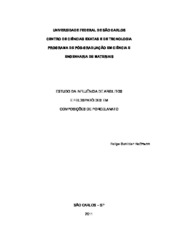| dc.contributor.author | Hoffmann, Felipe Schlittler | |
| dc.date.accessioned | 2016-06-02T19:12:15Z | |
| dc.date.available | 2011-11-29 | |
| dc.date.available | 2016-06-02T19:12:15Z | |
| dc.date.issued | 2011-03-03 | |
| dc.identifier.citation | HOFFMANN, Felipe Schlittler. Study of influence of argilites and feldspathoids in compositions of stoneware tile. 2011. 118 f. Dissertação (Mestrado em Ciências Exatas e da Terra) - Universidade Federal de São Carlos, São Carlos, 2011. | por |
| dc.identifier.uri | https://repositorio.ufscar.br/handle/ufscar/851 | |
| dc.description.abstract | Considering the various types of ceramic tiles used today, the stoneware tile is distinguished by its aesthetic and technical characteristics, such as: very low water absorption (less than 0.5%), high mechanical strength, high abrasion strenght, high chemical and frost strenght. Commonly, a composition of stoneware tile is constituted by homogeneous mixture of plastic clay(s), kaolin, feldspar, quartz and talc of high purity. This work studied the effect of replacing the plastic clay used in the manufacture of this product, typically a clay, by a mudstone of lower refractoriness. Another object of study was to evaluate the influence of the replacement, even partially, the content of feldspar (which is the raw material most suitable flux and used industrially, around 45% by mass) for nepheline, evaluating the technical characteristics achieved in the final product. For this, emphasis was given to the use of different levels and types of trainers from the liquid phase (feldspar and nepheline) in compositions of bath with the mudstone. For comparison it was characterized, by means of physical tests, the linear shrinkage and water absorption (vitrification curve), and flexural strength of a standard composition, reported in the literature, and new compositions. In addition, it was evaluated the cycle and the level of firing (1200 ° C is the temperature industrial average), verifying the possibility of reducing consumption of natural gas, which represents the main energy source of the production process. | eng |
| dc.description.sponsorship | Universidade Federal de Sao Carlos | |
| dc.format | application/pdf | por |
| dc.language | por | por |
| dc.publisher | Universidade Federal de São Carlos | por |
| dc.rights | Acesso Aberto | por |
| dc.subject | Revestimentos cerâmicos | por |
| dc.subject | Porcelanato | por |
| dc.subject | Argilito | por |
| dc.subject | Feldspato | por |
| dc.subject | Nefelina | por |
| dc.title | Estudo da influência de argilitos e feldspatóides em composições de porcelanato | por |
| dc.title.alternative | Study of influence of argilites and feldspathoids in compositions of stoneware tile | eng |
| dc.type | Dissertação | por |
| dc.contributor.advisor1 | Morelli, Márcio Raymundo | |
| dc.contributor.advisor1Lattes | http://genos.cnpq.br:12010/dwlattes/owa/prc_imp_cv_int?f_cod=K4780873E7 | por |
| dc.description.resumo | Considerando-se os vários tipos de revestimentos cerâmicos utilizados atualmente, o porcelanato se destaca por sua estética e por suas características técnicas, tais como: baixíssima absorção de água (menor que 0,5%), elevadas resistências mecânica, à abrasão, química e ao gelo. Comumente, uma composição de porcelanato é constituída da mistura homogênea de argila(s) plástica(s), caulim, feldspato, quartzo e talco, de elevada pureza. Neste trabalho estudou-se o efeito da substituição da argila plástica utilizada na fabricação desse produto, tipicamente uma argila caulinítica, por um argilito de menor refratariedade. Outro objeto de estudo foi avaliar a influência da substituição, mesmo que parcial, do teor de feldspato (que corresponde à matéria-prima fundente mais indicada e utilizada industrialmente, em torno de 45% em massa) por nefelina, avaliando-se as características técnicas alcançadas no produto final. Para isto, ênfase foi dada à utilização de diferentes teores e tipos de formadores de fase líquida (feldspato e nefelina) em composições de massas com o argilito. Para comparação caracterizou-se, por meio de ensaios físicos, a retração linear de queima e absorção de água (curva de gresificação), e a resistência mecânica à flexão de uma composição padrão, reportada na literatura, e das novas composições. Além disso, avaliou-se o ciclo e o patamar de queima (1200°C é a temperatura industrial média), verificando-se a possibilidade de redução de consumo de gás natural, que representa a principal fonte energética do processo produtivo. | por |
| dc.publisher.country | BR | por |
| dc.publisher.initials | UFSCar | por |
| dc.publisher.program | Programa de Pós-Graduação em Ciência e Engenharia de Materiais - PPGCEM | por |
| dc.subject.cnpq | ENGENHARIAS::ENGENHARIA DE MATERIAIS E METALURGICA | por |
| dc.contributor.authorlattes | http://lattes.cnpq.br/8350754524180998 | por |
